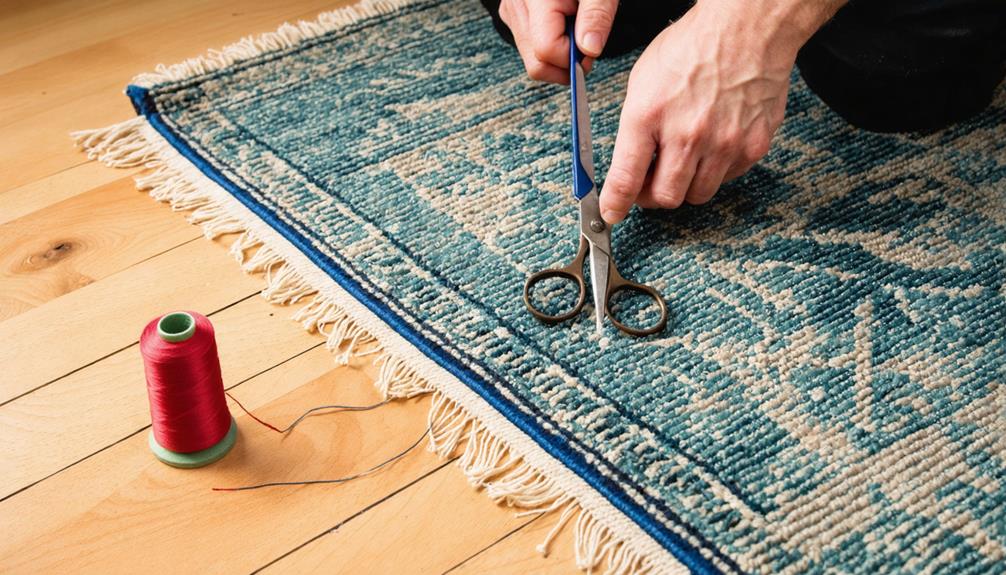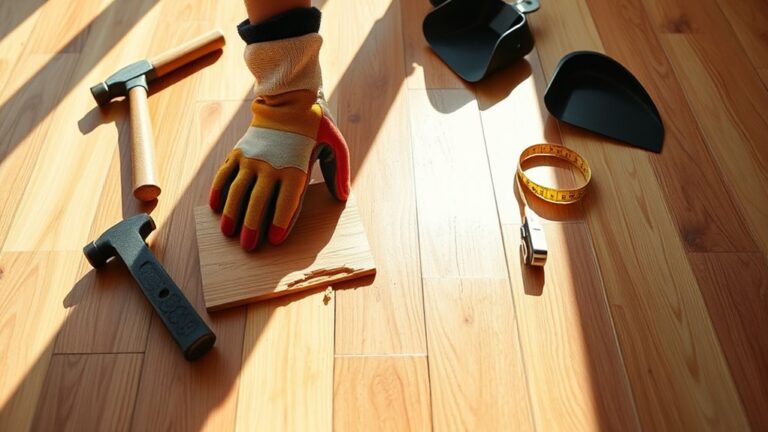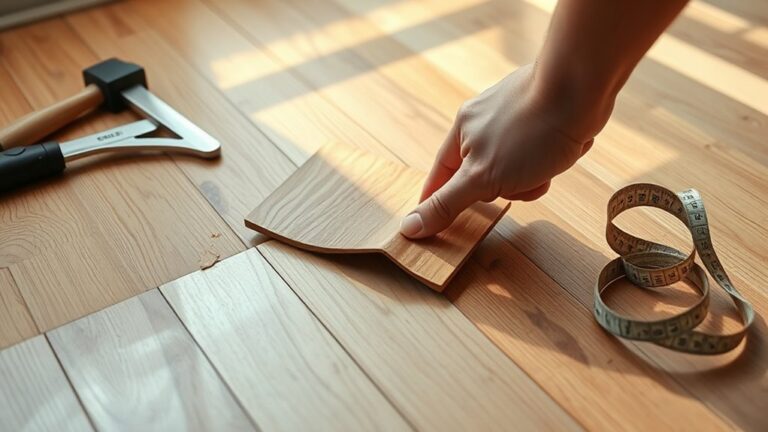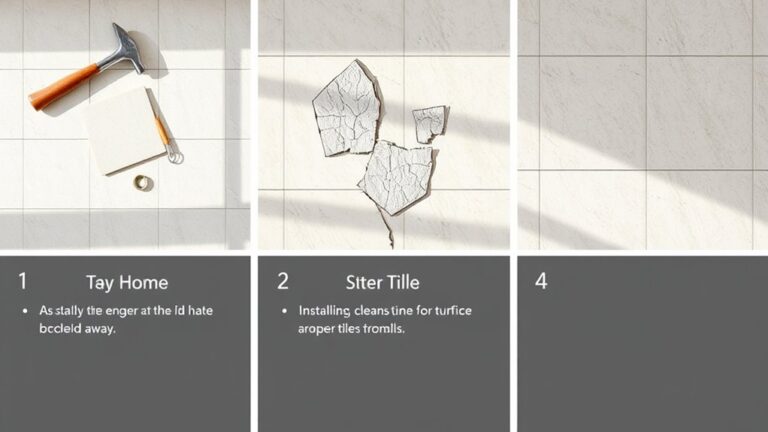Repairing worn or frayed carpet edges is crucial to preserving your carpet's look and durability. Start by vacuuming the area to clear debris, then inspect for loose threads that need securing. Use sharp scissors to trim excess fibers and apply a carpet glue evenly to the frayed area. Press the frayed fibers into the glue, guiding them with a straight edge for alignment. Place weights on the repair until the adhesive cures. To prevent future fraying, consider utilizing area rugs in high-traffic zones and maintaining pets' claws. There's more you can discover about further repair techniques and preventive measures.
Signs of Fraying Carpet Edges
When it comes to identifying signs of fraying carpet edges, you'll want to be vigilant for several key indicators that signal potential damage. One of the most noticeable signs is the presence of frayed edges along your carpet. If you see loose threads protruding, it's a clear indication that the carpet is starting to unravel, which can lead to further deterioration if not addressed promptly.
Another sign of fraying is an uneven texture along the borders of the carpet. This irregularity suggests structural issues that could compromise the carpet's integrity. If you notice any unraveling corners, this is a critical sign of fraying that necessitates urgent repair measures. Ignoring this can lead to more extensive damage and costly repairs later on.
Keep an eye out for fading colors, especially along the edges. This can highlight the wear and tear your carpet has experienced over time, often accompanying frayed edges. Additionally, bumps or lumps along the carpet's edge can signify fraying as well, indicating that the carpet's foundation is compromised.
Causes of Carpet Edge Fraying
Carpet edge fraying often occurs in high traffic areas where constant foot movement leads to significant wear. If the installation wasn't done properly, with adequate stretching and securing, you may notice fraying edges more quickly. Understanding these causes can help you take preventative measures to extend the life of your carpet.
High Traffic Areas
Frequent foot traffic in high traffic areas can lead to significant wear and fraying of carpet edges over time. The constant pressure from heavy footfalls weakens the fibers, causing frayed edges that can detract from your home's appearance. Carpets made from low-quality materials are especially vulnerable, as they lack the durability to withstand daily use. Additionally, pets can exacerbate fraying issues; their claws snag and tear the fibers, resulting in visible damage.
To help mitigate fraying in these areas, consider the following practical solutions:
- Place area rugs or runners: These can protect the carpet underneath from excessive wear.
- Implement a regular cleaning routine: Vacuuming frequently will remove dirt and debris that can wear down fibers.
- Encourage gentle foot traffic: Where possible, guide traffic patterns to minimize wear in specific spots.
- Choose durable carpet materials: When installing new carpets, opt for those designed to withstand high traffic.
Poor Installation Techniques
Improper installation techniques can considerably contribute to carpet edge fraying, often going unnoticed until damage becomes evident. When you choose the wrong Type of Carpet or rely on inexperienced installers, you're risking frayed edges that can ruin your flooring. Here's a breakdown of common issues:
| Installation Issue | Impact on Carpet Edges | Prevention Tips |
|---|---|---|
| Inadequate stretching | Carpet shifts, leading to fraying | Use a knee kicker for tension |
| Improper padding cuts | Unsecured carpet, causing wear | Verify padding is cut correctly |
| Poor attachment to strips | Loose edges prone to fraying | Securely attach carpet to strips |
| Overlooking corners | Vulnerable edges from daily use | Double-check all corners |
| Lack of proper tools | Uneven tension increases fraying risk | Invest in quality installation tools |
Essential Tools for Repair
When tackling carpet edge repairs, which tools do you really need to guarantee a successful outcome? Having the right equipment is fundamental for a neat and durable fix. Here's a list of essential tools that'll help you get the job done effectively:
- Carpet Glue: This is crucial for securing loose threads and preventing further fraying. A strong adhesive guarantees your repair lasts.
- Sharp Scissors or a Knife: You'll need these for precise trimming of frayed edges. A clean cut leads to a polished finish that looks professional.
- Straight Edge or Ruler: Using a straight edge allows you to maintain straight cuts, which is vital for achieving a seamless look when repairing.
- Heavy Books or Weights: After applying carpet glue, these will help apply pressure during the drying process, ensuring the repair adheres properly.
Before you start, don't forget to clean the area thoroughly with a vacuum cleaner. Removing dirt and debris is fundamental because it allows the adhesive to bond more effectively. A clean workspace not only enhances the quality of your repair but also saves you time down the line. By gathering these tools beforehand, you'll be prepared to tackle your carpet edge repair with confidence and precision. Each tool plays a key role in achieving a successful and aesthetically pleasing result, so make sure you have everything ready to go.
Step-by-Step Repair Process
To start the repair process, you'll need to prepare the damaged area by trimming any excess threads and vacuuming it for a clean surface. Next, you'll apply carpet repair glue to secure the frayed edges, ensuring even coverage. Finally, distribute the mixed color fibers over the adhesive to finalize the repair and mimic the carpet's original texture.
Preparing the Damaged Area
Preparing the damaged area is essential for a successful carpet edge repair. Start by guaranteeing the surface is clean and ready for work. Here's how you can do it effectively:
- Vacuum the damaged area to remove dirt and debris, making the surface clean for repair.
- Inspect the frayed edges to identify loose threads that need stabilization.
- Use sharp scissors to trim any excess fibers or threads that could disrupt a smooth repair.
- Apply a small amount of carpet glue evenly along the frayed area to secure loose threads and prevent further fraying.
Once you've applied the glue, place heavy books or weights on the repaired area until the adhesive dries completely. This pressure guarantees a strong bond, essential for longevity. Remember, a thorough preparation will make the actual repair process smoother and more effective. Whether you're dealing with minor fraying or extensive wear, these steps will set the foundation for a successful fix. Taking the time to prepare properly can save you headaches down the road, allowing your carpet to look its best for years to come.
Applying Carpet Repair Glue
Applying carpet repair glue requires careful attention to detail to guarantee a durable fix. Start by thoroughly cleaning the damaged area with a vacuum to eliminate any dirt and debris. This step is vital, as a clean surface guarantees better adhesion for the carpet repair glue.
Next, take a small brush or applicator and apply a thin, even layer of glue directly onto the frayed carpet edges. Precision is key here; make sure the adhesive covers the area without excess pooling. Gently press the frayed carpet fibers into the glue, aligning them with the surrounding texture for a seamless look.
To maintain a neat appearance, use a straight edge or ruler to guide the placement of the glued area. Trim any excess fibers before the glue dries to avoid an uneven finish. Once you're satisfied with the alignment, place heavy books or weights on the repaired section. This guarantees even pressure while the carpet repair glue cures fully. Allow adequate time for the adhesive to set, which is essential for a long-lasting repair.
Finalizing the Repair Process
After the carpet repair glue has set and the frayed edges are secured, it's time to finalize the repair process. This step is vital to achieve a professional-looking finish that seamlessly blends with your carpet. Follow these steps carefully:
- Trim any excess threads around the repair area to guarantee a clean look.
- Vacuum the damaged area thoroughly to eliminate dirt and debris, promoting better adhesion.
- Mix matching color fibers and shake them well for uniformity before applying them.
- Carefully apply carpet glue evenly to the damaged area, then distribute the mixed fibers over the adhesive.
Once you've laid down the fibers, use a mesh sieve to pack them into the glue. This replicates the original fabric pattern, enhancing the repair's appearance. Finally, allow the repair to dry completely before walking on the area. This drying time is essential for durability and maintaining that professional-looking finish. By following these steps, you'll restore your carpet's integrity while enjoying the freedom that comes with a well-executed DIY repair.
Preventing Future Fraying
Although fraying carpet edges can be a frustrating issue, implementing preventive measures can considerably prolong the life of your carpet. Start by investing in high-quality carpets made from durable materials. These carpets resist wear and tear far better than low-quality options, considerably reducing fraying. Additionally, placing area rugs in high-traffic areas absorbs foot traffic impact, helping to protect your carpet edges.
Regular vacuuming is another essential practice. It prevents dirt buildup, which contributes to fiber breakdown, ultimately extending the lifespan of your carpet edges. If you have pets, keep their claws trimmed and consider establishing a pet-free zone on carpets to minimize the risk of snags and fraying caused by scratching.
Avoid placing heavy furniture directly on carpet edges, as this can create unnecessary pressure, leading to structural issues and fraying. Below is a practical guide to preventing future fraying:
| Preventive Measure | Description |
|---|---|
| Invest in Quality Carpets | Choose durable materials to reduce wear and tear. |
| Use Area Rugs | Shield high-traffic areas from excessive damage. |
| Regular Vacuuming | Keep dirt at bay to protect fibers. |
| Maintain Pets' Claws | Prevent snags by keeping claws trimmed. |
| Avoid Heavy Furniture | Reduce pressure on carpet edges to prevent issues. |
Repair vs. Replace Decisions
Even with preventive measures in place, carpet edges can still suffer damage over time, prompting the need to evaluate whether to repair or replace. When making these repair vs. replace decisions, you should consider several important factors to ascertain you're acting in the best interest of your carpet needs.
- Extent of Damage: Assess how severe the frayed edges are. Minor fraying can often be repaired, while extensive damage might necessitate replacement.
- Age of the Carpet: If your carpet is nearing the end of its lifespan, investing in repairs may not be justified. A new installation might be more beneficial.
- Overall Condition: Look at other issues, like matting or discoloration, that could affect your decision. A carpet with multiple problems may not be worth saving.
- Budget Considerations: Keep in mind that repairs may be less expensive initially, but if the carpet continues to deteriorate, you might face further costs down the line.
Deciding whether to repair or replace requires a careful analysis of these factors. If the frayed edges are minor and the carpet is still in good shape, a repair can extend its life and save you money. However, if you're dealing with an aging carpet with multiple issues, it may be wiser to invest in a new one. Ultimately, aligning your decision with your aesthetic preferences and practical considerations will lead to a satisfying outcome.
Additional Repair Techniques
When tackling frayed carpet edges, several effective repair techniques can help restore the integrity and appearance of your flooring. One method to contemplate is whip stitching. You'll need a heavy-duty polyester thread and a 6-inch upholstery needle. By performing whip stitches on the frayed edges, overlapping the stitches for added durability, you can greatly strengthen the area.
Another useful technique is applying anti-fray glue. This glue can be used on the trimmed edges of your carpet to prevent further fraying and secure any loose threads. This step not only enhances the longevity of the repair but also maintains a neat appearance.
If the damage is more extensive, a patch repair might be necessary. Carefully cut out the damaged section and replace it with a matching piece of carpet, securing it in place with adhesive or seam tape. This approach allows for a seamless look that blends well with the existing carpet.
For situations where fraying occurs at connection points, think about re-stretching techniques. Using a knee kicker to stretch the carpet forward and secure it to the tack strip can eliminate fraying while preventing further damage.
Lastly, installing a carpet bar over the frayed area acts as a connection piece, protecting the edges and providing a clean finish. This not only secures the carpet but also enhances the overall aesthetic of your flooring. By employing these additional repair techniques, you can effectively address frayed edges and maintain your carpet's condition.
Frequently Asked Questions
How to Fix Frayed Carpet Edges?
You wouldn't believe the chaos frayed carpet edges can cause! To tackle this, start by vacuuming the area to clear debris. Then, employ carpet trimming techniques to snip any excess fibers. For lasting results, consider edge binding methods—apply carpet glue to secure loose threads. Finally, don't forget fraying prevention tips, like using weights to guarantee everything sets perfectly. You'll have your carpet looking pristine in no time!
How to Stop Edge of Carpet Fraying?
To stop the edge of your carpet from fraying, consider implementing effective carpet maintenance tips. Regularly trim loose threads and apply anti-fray glue as edge sealing methods. You should also use fraying prevention techniques, like installing durable carpets and placing area rugs in high-traffic areas. Don't forget to vacuum often to remove debris that can weaken fibers. Proper installation and securing edges can further enhance longevity, ensuring your carpet remains in great condition.
How Do You Fix Down Carpet Edges?
Did you know that proper carpet edge maintenance can extend your carpet's life by up to 50%? To fix down carpet edges, gather carpet repair tools like glue and scissors. Use edge binding techniques to secure loose threads, applying glue evenly for a strong hold. Trim any excess fibers for a tidy appearance. For added protection, consider installing a carpet bar. Regular upkeep will keep your carpet looking fresh and minimize future issues.
How to Repair Worn Carpet?
To repair worn carpet, you'll want to start with carpet patching techniques for a seamless fix. First, clean the damaged area thoroughly. For effective carpet edge treatment, apply adhesive to secure loose fibers and trim any excess. Follow up with carpet maintenance tips like using a carpet protector to prevent future wear. Always guarantee you let the adhesive cure completely before walking on the repair to maintain its integrity and appearance.




